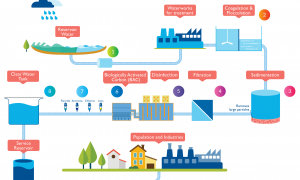🕑 Reading time: 1 minute
A pump is a mechanical device that lifts liquids from a lower level or low-pressure area to a higher level or high-pressure area. It is a heavy-duty equipment with low suction and high discharge pressure. This makes it easier to pump a fluid from a certain depth and push the fluid to the desired height.
Pumps can also be used as a booster in a pipeline network system. Pumps have evolved into an endless variety having different sizes, types, and applications. This article covers the requirements, factors of selection, and types of pumps in the water supply system.
Contents:
1. Requirement of Pumps
A water supply scheme requires pumps at multiple stages.
- In the case of groundwater sources and low-leveled surface sources, pumps are required to lift the water as it cannot flow under gravity.
- When sufficient slope is not available at a treatment plant to facilitate the gravitational flow of water, pumps become a necessity.
- After treatment, the water has to be forced into the distribution mains. Pumps play a vital role in forcing out the water either directly or through a service reservoir.
- In the distribution mains, the pressure has to be boosted or increased at a few intermediate points. Pumps provide the required pressure so that the water reaches the required height in multistoried buildings.
2. Types of Pumps
There are various types of pumps available in the market and they can be classified depending on their application, size of construction materials, orientation, etc. One of the common classifications is based on the principle of the type of energy applied to the water. The two categories of pumps are rotodynamic pumps and positive displacement pumps.
2.1 Rotodynamic Pumps
A rotodynamic pump has a wheel or rotating element that rotates the water inside a case. The rotating element is called an impeller and it helps in imparting energy to the water. The shape of the impeller should be such that it forces the water outward in a direction at right angle to its axis or give the water both, an axial as well as radial velocity or force the water in axial direction alone.
Based on the type of force imparted, rotodynamic pumps can be further classified into centrifugal or axial-flow pumps.
2.1.1 Centrifugal Pump
Mixed flow and radial flow machines are typically called as centrifugal pumps.

It could be either open or closed based on the amount of suspended solids present in the water. The closed impeller has plates on each side of the vanes and the open impeller has a hub with vanes attached to it. The efficiency of the closed impeller centrifugal pump is more than that of an open impeller centrifugal pump.
2.1.2 Axial-Flow Pump
Axial-flow machines are generally called as axial-flow pumps. In these pumps, the fluid is pumped in a direction parallel to the shaft.
2.2 Displacement or Positive-Displacement Pumps
This pump works on the principle of mechanically inducing a vacuum in a chamber. Based on this principle, the pump draws in water which is displaced mechanically and is then forced out of the chamber. Reciprocating pumps and rotary pumps are the two types of positive-displacement pumps.
2.2.1 Reciprocating pump
The reciprocating pumps help transfer a certain quantity of liquid by application of pressure. The hand pump is one of the most commonly used reciprocating pumps but is considered to be an outdated system.

2.2.2 Rotary Pump
In this pump, the rotary motion is achieved by using a pair of cams or gears that mesh together and rotate in opposite directions.
3. Factors for Selecting the Type of Pump
The various factors that are needed to be taken into consideration while selecting a pump for a particular project are as follows:
- Capacity of the pump
- Significance of the water supply project
- Cost of the pumping arrangement
- Maintenance cost of the project
- Quantity of water to be pumped
- Size and orientation of the pump
- Number of pumping units required for a project
FAQs
A pump is a mechanical device that lifts liquids from a lower level or low-pressure area to a higher level or high-pressure area.
The two major categories of pumps are rotodynamic pumps and positive displacement pumps.
Read More
Centrifugal Pump – Components, Working, Types and Application
COMPARISON BETWEEN CENTRIFUGAL & RECIPROCATING PUMPS


